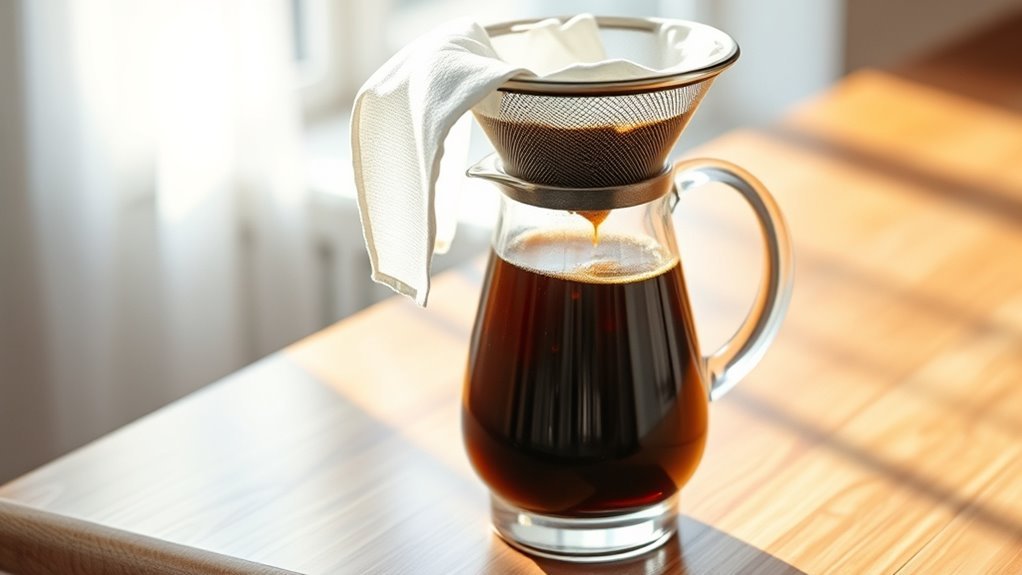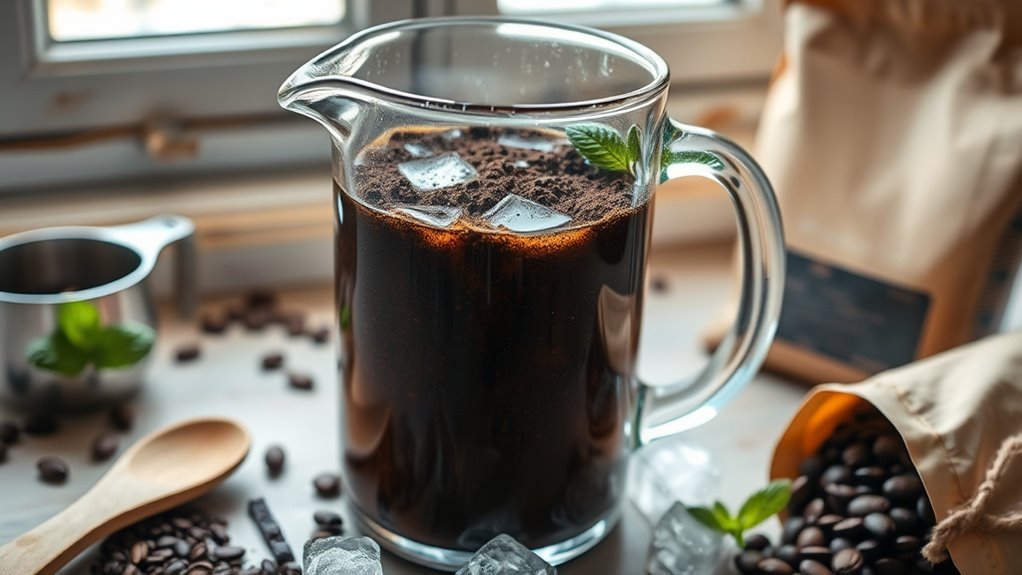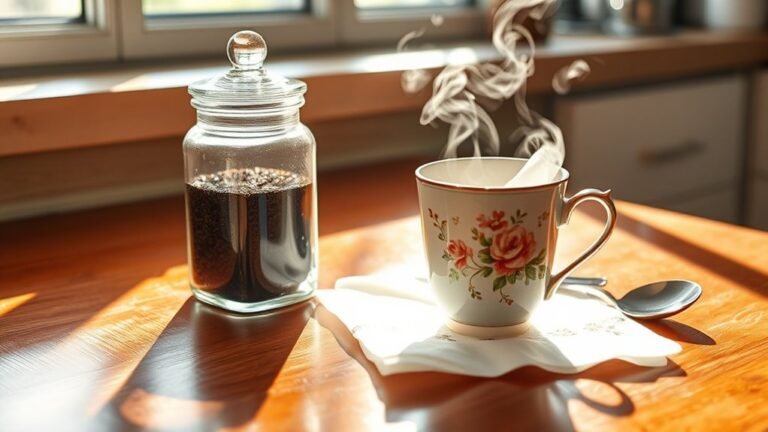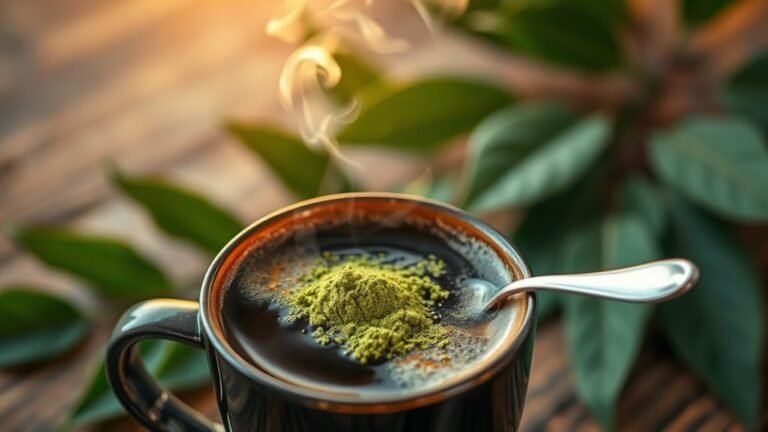How to Make Cold Brew Coffee at Home
To make cold brew at home, start with fresh, medium to dark roasted Arabica beans for smooth, chocolatey notes. Grind them coarsely using a burr grinder to guarantee even extraction. Combine grounds with cold, filtered water and steep at room temperature for 12 to 24 hours, then strain through a fine mesh and cheesecloth for clarity. Serve over ice, dilute to taste, and refrigerate in an airtight container. Master these essentials, and you’ll reveal a rich, balanced brew with expert finesse.
Choosing the Right Coffee Beans

Selecting the right coffee beans is essential for crafting a cold brew that highlights smoothness and rich flavor. You’ll want to explore various coffee bean types—Arabica beans typically offer sweeter, more nuanced flavor profiles, while Robusta beans bring a stronger, more bitter edge. For cold brew, beans with medium to dark roasts are preferred, as they provide chocolatey, nutty notes and lower acidity, enhancing the brew’s smoothness. Keep in mind that single-origin beans can deliver distinctive regional flavors, giving you freedom to tailor your cold brew experience. When choosing, prioritize freshness and consider beans with flavor profiles that suit your taste—whether fruity, earthy, or caramel-like. Selecting thoughtfully guarantees your cold brew starts with a balanced, rich foundation.
Grinding Your Coffee for Cold Brew
Because grind size directly influences extraction rates and overall flavor balance, mastering the right grind for cold brew is essential. For cold brew, you’ll want a coarse grind—think chunky, similar to raw sugar crystals. This larger particle size slows extraction, preventing over-extraction and bitterness while preserving a smooth, rich flavor profile. Avoid finer grinds, which can lead to a cloudy, harsh brew and complicate filtration. Use a burr grinder for consistency, as blade grinders produce uneven particles that disrupt balance. Adjust grind size slightly depending on your beans and taste preferences, but always prioritize evenness to maintain clarity and control bitterness. By dialing in your grind size, you’re setting the foundation for a clean, well-rounded cold brew that highlights the beans’ natural characteristics and offers you the freedom to craft your perfect cup.
Brewing Process and Steeping Time
With your grind dialed in to that coarse, even texture, the next step is to focus on the brewing process and steeping time, which directly shape the extraction and flavor development. Start by combining your grounds with cold, filtered water at room temperature—this steeping temperature prevents over-extraction and bitterness. Choose brewing equipment that suits your style: a large mason jar, a dedicated cold brew maker, or even a French press. Stir gently to guarantee all grounds are saturated. Cover and let it steep undisturbed for 12 to 24 hours; shorter times yield a lighter profile, longer steeping intensifies boldness and body. Remember, consistency in steeping temperature and time is key to releasing smooth, rich cold brew with minimal acidity. Adjust these parameters to craft your ideal cup.
Straining and Filtering Your Cold Brew

After steeping your cold brew to perfection, the next critical step is straining and filtering to separate the grounds from your concentrate. Begin by using a coarse strainer or a fine mesh sieve to remove the bulk of coffee grounds. For a cleaner cup, follow up with filtering options like a cheesecloth, nut milk bag, or a paper coffee filter. These straining techniques minimize sediment and clarify the brew without stripping essential oils that give cold brew its smooth profile. You can also double strain by pouring the concentrate through two layers of filtering material. This approach guarantees your cold brew is silky and free from grit, giving you the freedom to enjoy a pure, rich coffee concentrate every time. Choose the method that suits your rhythm and equipment best.
Serving and Storing Cold Brew Coffee
Cold brew coffee, once strained and filtered, is ready to be served or stored appropriately to maintain its rich flavor and vitality. For serving suggestions, pour your cold brew over ice, or dilute with water or milk to taste, preserving that smooth, bold profile. You can also experiment with flavored syrups or a splash of cream to elevate your experience. When it comes to cold storage, transfer your brew into an airtight container and refrigerate immediately. Cold brew keeps best within 1 to 2 weeks, but for peak vitality, consume within 7 days. Avoid room temperature to prevent flavor degradation. Appropriate storage guarantees you’re always ready to enjoy a crisp, invigorating cup at your convenience, giving you the freedom to savor quality coffee anytime.
Frequently Asked Questions
Can I Use Flavored Coffee Beans for Cold Brew?
Imagine your morning coffee as a canvas, and flavored beans are the vibrant paints. You can absolutely use flavored beans for cold brew; they infuse unique notes that traditional beans can’t match. Just remember, your brewing techniques—like grind size and steep time—impact flavor extraction. Coarser grounds and a 12-24 hour steep bring out the delicate essences, giving you a smooth, adventurous cup that feels as free as your spirit.
How Long Can Cold Brew Coffee Be Stored in the Fridge?
You can store cold brew coffee in the fridge for up to two weeks, which is its typical shelf life. To maintain ideal flavor and freshness, keep it in an airtight container, preferably glass. Avoid frequent exposure to air and light, which degrade the coffee’s nuanced notes. For best results, store your cold brew concentrate separately from water or milk, and mix just before serving to savor that smooth, bold profile.
Is Cold Brew Coffee Less Acidic Than Hot Brewed Coffee?
Think of acidity levels as the brightness in a painting—cold brew offers a softer, smoother hue. Because cold brewing extracts coffee compounds slowly with cold water, it reduces the release of acidic oils and compounds compared to hot brewing methods. So, you’ll find cold brew coffee less acidic, making it gentler on your stomach and perfect if you crave a mellow, bold cup without the sharp tang typical of hot brewed coffee.
Can I Use Instant Coffee to Make Cold Brew?
You can use instant coffee to make cold brew alternatives, but it’s not traditional cold brew. Instant coffee benefits include quick preparation and convenience, perfect when you want that smooth, chilled coffee without the wait. Simply dissolve instant coffee granules in cold water, adjusting strength to your taste, then chill. While it won’t have the same depth or nuanced flavors as steeped grounds, it’s a freeing, efficient option for cold coffee lovers.
What Water Quality Is Best for Making Cold Brew?
When making cold brew, you’ll want to use filtered water with a balanced mineral content. Too few minerals can make your coffee taste flat, while too many can cause bitterness or off-flavors. Filtered water guarantees impurities don’t interfere with extraction, letting the coffee’s natural sweetness and smoothness shine. Aim for water with a moderate mineral balance to release a clean, crisp, and flavorful cold brew that gives you the freedom to enjoy every sip.






